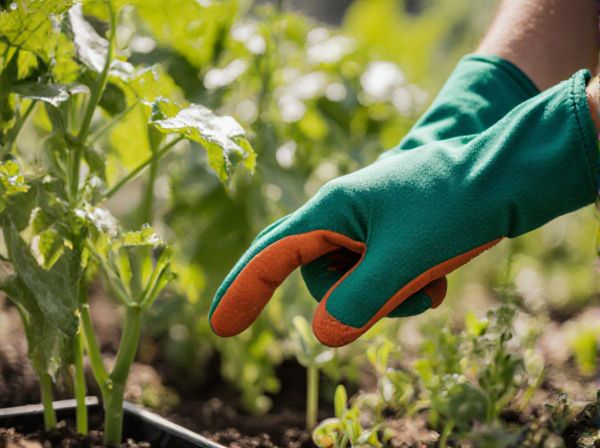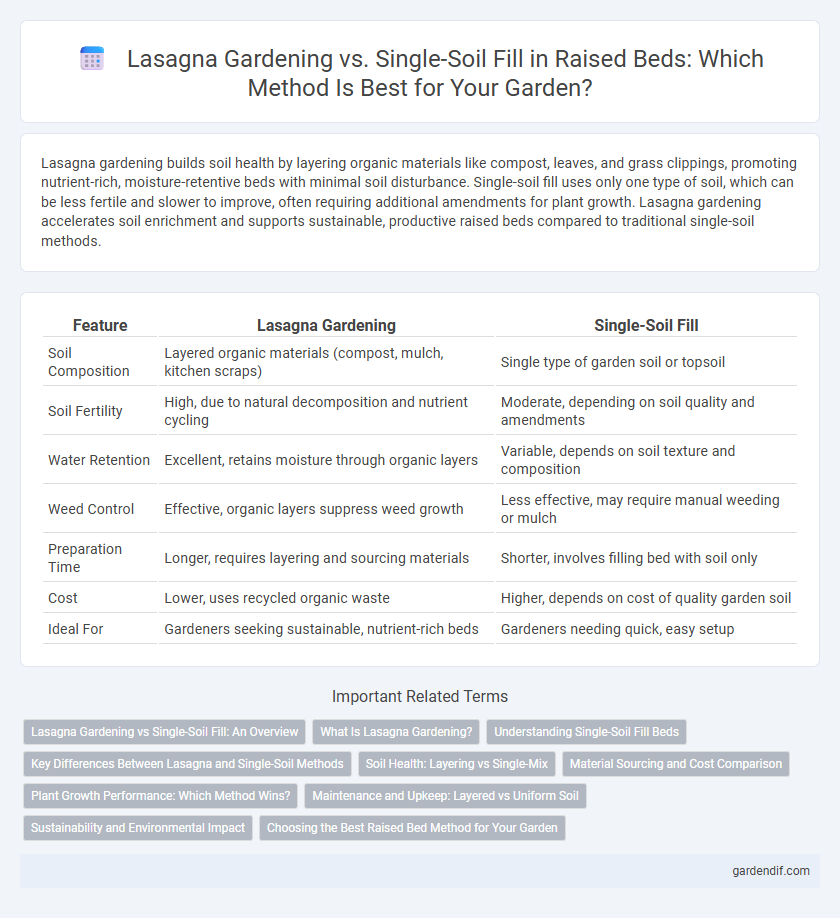
Lasagna gardening vs Single-soil fill Illustration
Lasagna gardening builds soil health by layering organic materials like compost, leaves, and grass clippings, promoting nutrient-rich, moisture-retentive beds with minimal soil disturbance. Single-soil fill uses only one type of soil, which can be less fertile and slower to improve, often requiring additional amendments for plant growth. Lasagna gardening accelerates soil enrichment and supports sustainable, productive raised beds compared to traditional single-soil methods.
Table of Comparison
| Feature | Lasagna Gardening | Single-Soil Fill |
|---|---|---|
| Soil Composition | Layered organic materials (compost, mulch, kitchen scraps) | Single type of garden soil or topsoil |
| Soil Fertility | High, due to natural decomposition and nutrient cycling | Moderate, depending on soil quality and amendments |
| Water Retention | Excellent, retains moisture through organic layers | Variable, depends on soil texture and composition |
| Weed Control | Effective, organic layers suppress weed growth | Less effective, may require manual weeding or mulch |
| Preparation Time | Longer, requires layering and sourcing materials | Shorter, involves filling bed with soil only |
| Cost | Lower, uses recycled organic waste | Higher, depends on cost of quality garden soil |
| Ideal For | Gardeners seeking sustainable, nutrient-rich beds | Gardeners needing quick, easy setup |
Lasagna Gardening vs Single-Soil Fill: An Overview
Lasagna gardening layers organic materials like compost, straw, and kitchen scraps to create nutrient-rich soil that improves drainage and promotes microbial activity. Single-soil fill involves adding a uniform layer of soil in one step, which is quicker but often lacks the complex nutrient profile and aeration benefits of lasagna gardening. Lasagna gardening enhances soil fertility and moisture retention more effectively than single-soil fill, supporting healthier plant growth over time.
What Is Lasagna Gardening?
Lasagna gardening is a no-dig raised bed method that builds fertile soil through layers of organic materials like compost, leaves, straw, and kitchen scraps, mimicking natural soil formation. This technique enriches soil structure, retains moisture, and improves nutrient availability compared to traditional single-soil fill beds that rely solely on importing and filling with soil. By promoting microbial activity and reducing soil compaction, lasagna gardening enhances plant growth and sustainability in raised bed gardening systems.
Understanding Single-Soil Fill Beds
Single-soil fill beds consist of filling raised garden beds entirely with a uniform soil mixture, providing consistent nutrient and moisture levels throughout the root zone. This method simplifies maintenance by avoiding layered decomposing materials found in lasagna gardening, reducing the risk of uneven settling and nutrient imbalances. Single-soil fill is ideal for gardeners seeking efficient planting conditions and streamlined soil management without the complexity of multiple organic layers.
Key Differences Between Lasagna and Single-Soil Methods
Lasagna gardening builds soil health by layering organic materials like compost, leaves, and grass clippings, creating nutrient-rich, well-draining beds that enhance microbial activity. Single-soil fill uses a uniform soil mix, which may lack the diverse organic matter layers for sustained nutrient release and improved soil structure. The key differences lie in organic layering complexity, soil fertility dynamics, and long-term soil health benefits.
Soil Health: Layering vs Single-Mix
Lasagna gardening enhances soil health through layered organic materials that improve aeration, moisture retention, and nutrient cycling by decomposing over time. Single-soil fill relies on a homogeneous mix, which may lack the diverse structure and microbial activity fostered by layered decomposition. Layering in lasagna gardening promotes richer, more fertile soil compared to the relatively uniform composition of single-soil fill.
Material Sourcing and Cost Comparison
Lasagna gardening utilizes layers of organic materials like kitchen scraps, leaves, and compost, often sourced for free or low cost, making it an economical choice for environmentally-conscious gardeners. In contrast, single-soil fill demands bulk purchase of high-quality topsoil or garden mix, which can significantly increase upfront costs due to volume requirements. Material sourcing for lasagna gardening promotes sustainable waste recycling, whereas single-soil fill relies heavily on commercial soil vendors, influencing overall budget and ecological impact.
Plant Growth Performance: Which Method Wins?
Lasagna gardening enhances plant growth performance by layering organic materials that improve soil structure, nutrient availability, and moisture retention, promoting robust root development and higher yields. In contrast, single-soil fill often lacks the diverse microbial activity and nutrient complexity of lasagna beds, potentially limiting plant vigor and growth rate. Studies show lasagna gardening consistently outperforms single-soil fill in plant health and productivity due to its enriched, well-aerated growing medium.
Maintenance and Upkeep: Layered vs Uniform Soil
Lasagna gardening requires ongoing maintenance to monitor and replenish decomposing organic layers, ensuring nutrient balance and soil health. Single-soil fill offers uniform soil that demands less frequent intervention, simplifying upkeep but potentially lacking the rich microbial diversity of layered beds. The layered approach promotes enhanced moisture retention and aeration, while uniform soil systems often need supplemental watering and fertilization to maintain optimal plant growth.
Sustainability and Environmental Impact
Lasagna gardening enhances sustainability by layering organic materials that decompose, enriching soil fertility without synthetic inputs, which reduces waste and promotes carbon sequestration. Single-soil fill often involves using commercially mixed soil that may require chemical fertilizers, potentially leading to nutrient runoff and lower biodiversity. Emphasizing natural decomposition and resource recycling, lasagna gardening supports environmental health more effectively than a single-soil fill approach.
Choosing the Best Raised Bed Method for Your Garden
Lasagna gardening builds soil fertility through layered organic materials, promoting moisture retention and rich nutrient availability, ideal for gardeners seeking sustainable growth. Single-soil fill involves filling the raised bed entirely with high-quality soil, providing immediate planting readiness and control over soil composition. Selecting the best raised bed method depends on factors like garden goals, soil quality, and time investment, with lasagna gardening enhancing soil health over time and single-soil fill offering faster setup and planting convenience.
Lasagna gardening vs Single-soil fill Infographic

 gardendif.com
gardendif.com